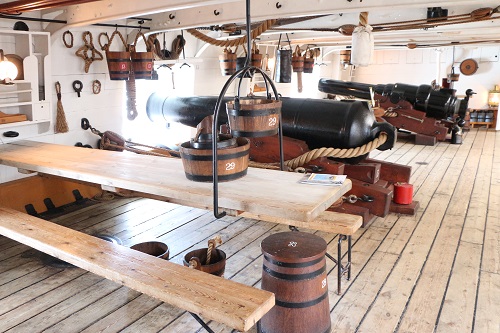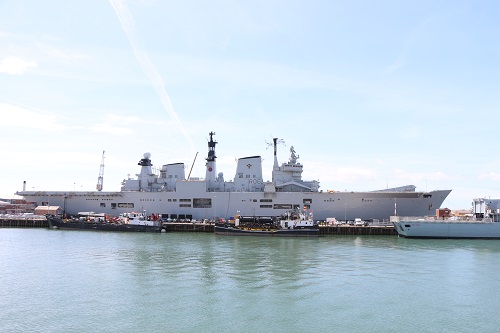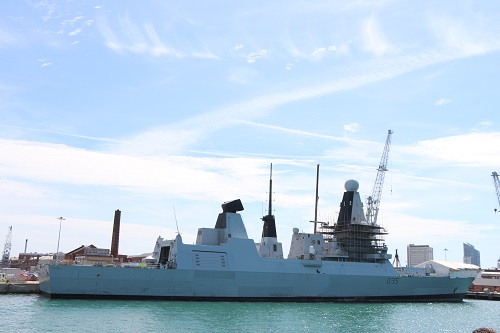 Today, I visited the Portsmouth Historic Dockyard in Portsmouth, UK, together with my kids. Somewhat surprisingly maybe, the kids mostly loved it and I got to see and learn a lot of interesting history. I found it particularly usful to compare the three main ships on display: the 1510 Mary Rose, the 1765 HMS Victory, and the 1860 HMS Warrior. They show both the development and continuity of the Royal Navy over a very long period of time.
Today, I visited the Portsmouth Historic Dockyard in Portsmouth, UK, together with my kids. Somewhat surprisingly maybe, the kids mostly loved it and I got to see and learn a lot of interesting history. I found it particularly usful to compare the three main ships on display: the 1510 Mary Rose, the 1765 HMS Victory, and the 1860 HMS Warrior. They show both the development and continuity of the Royal Navy over a very long period of time.
What is very striking when you visit HMS Warrior and HMS Victory on the same day is just how similar their internals are. The ships were built 100 years apart, and HMS Warrior is built from iron and steel with a steam engine as primary locomotion. Still, the gun deck looks like the deck on Victory – the guns are bigger, and the space is much larger and better lit, but it still works the same way. The crew eats on tables between the guns, and sleep in hammocks suspended above the guns. The food is served from a central galley in the middle of the gun deck. Even the Mary Rose had a similar structure: it has gun ports too, which was something quite new for its time. So, over 300 years, a war ship had guns sticking out the sides through ports. A sailor from the Mary Rose would probably recognize the structure of HMS Warrior, even if he would be amazed by the size of the guns – and most likely scared to death by the steam engine.
On HMS Warrior, the gun deck and crew’s table looks like this:

While on HMS Victory, it looks like this:

Very similar (see the HMS Victory website for some better pictures). HMS Warrior adds conveniences like metal plates and a little stand for the plates next to the outside wall. The Mary Rose is a raised wreck, so you do not see as much of how people lived on board there. Still, it seems that the tables came later, and that the crew of the Mary Rose eat on the floor or sitting on various storage containers.
Another thing common to all the ships is infantry weapons. Here is a rifle and bayonet stand from the HMS Warrior – with storage for a few 110 pound explosive shells underneath.

On both HMS Warrior and HMS Victory, there are sabers and pistols and rifles with bayonets at the handy in stands – which made some sense at the time HMS Victory was active. Boardings did happen, and if a pirate or Frenchman came too close, having a saber handy could save the ship. However, it is hard to see how a pirate would come swinging in over the side of HMS Warrior, as its steam engine would let it keep its distance and it would shoot armor-piercing explosive shells out to 3000 meters or so. HMS Victory was still fighting at a time where rifle fire from one ship to another made sense due to the short distances of a few hundred meters. Going back the Mary Rose, it started life as a ship primarily focused on boarding, but was gradually rebuilt into a primary gun platform. HMS Victory was built to be a gun platform, and HMS Warrior most definitely followed that tradition.
The hand weapons on the W and the V look similar but are quite different. HMS Warrior sports revolvers and breechloading rifles, while HMS Victory has flint locks. The Mary Rose, 200 years before the HMS Victory, sailed with longbowmen, halberds, bills, and pikes in addition to the handegonnes.
The main guns change much more obviously between the ships. HMS Victory has guns that go up to 32 pounds, with most of them 12 pounders. A single man can lift a 12-pound cannonball without difficulty. The 32 pound balls required a special harness for lifting by two men it seems. On HMS Warrior, we find 68 pounders as the smallest guns, and quite a few 110 pound breech loaders. The ammunition is still loaded by hand, requiring special handles for what seems like three men to carry the projectiles. The guns on the Mary Rose were far more primitive than those on the HMS Victory, but the shot was similar in size. Still, the guns all sit on carriages of the kind that was introduced at the time of the Mary Rose, and were still in use 300 years later.
However… after the HMS Warrior was put into the service, the speed of change accelerated insanely. HMS Victory was in active service for more than 50 years, and was not all that unlike the ships that took over after her. It took just ten years for HMS Warrior to become obsolete, with the launch of the first “mastless” ship. 50 years after her launch, we have Dreadnought-class battleships with 14-inch guns firing shells 10 times the weight of those on HMS Warrior, sailing at speeds unimaginable just 50 years earlier. Just too bad the British did not have the money and foresight to save one of the World War I era battleships for posterity. It would have made an excellent point of comparison.
Ships have grown bigger over time… the Mary Rose weighed 700 tons in its final guise. HMS Victory was 3500 tons of wood, and HMS Warrior 9500 tons of steel and wood. HMS Dreadnought in 1906 weighed in at 20000 tons, and the biggest battleships of World War II got up to to 50000 tons.
The Portsmouth Historic Dockyard is clearly worth a day’s visit, and don’t miss the harbor tour that showcases quite a bit of the modern Royal Navy. We got to see several Daring-class destroyers, as well as HMS Illustrious (which apparently will be retained as a museum ship).
HMS Illustrious:

HMS Dragon:

And for comparison, HMS Warrior (still with an aft cabin for the captain, admiral, and marines, just like HMS Victory)

I also remember that back in 2010, we had the conference dinner for the S4D conference aboard the Warrior, and it made quite an impression on me even then.